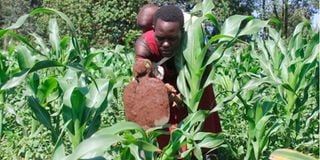Gapping maize plants for maximum yields

Ms Rhoda Bosibori works at a maize farm in Elburgon, Nakuru County on May 19, 2022.
It has been a week since Farmer Moses planted his maize seeds. Most of them have already started germinating and shooting.
He sufficiently did land preparation to facilitate a uniform germination percentage.
The farmer is observing hygiene measures by ensuring the farm is clean. He removed all the weeds around the farm because they serve as a haven for pests and diseases. Farmer Moses has also been scouting the crop to ensure it has adequate water as over-watering results in seeds rotting. Watering should be done depending on the soil moisture content.
Following seeding, some seeds may fail to germinate due to factors such as viability, pest and disease attack, scorching effect of fertiliser or insufficient watering.
When the seeds fail to germinate, empty spaces are seen within the rows. This if left unfilled can make the farmer incur losses as a result of low yields. The filling up of these spaces or the replacement of ungerminated seeds is called gapping. This helps in attaining 100 per cent plant population, an optimum plant population, and avoids wastage of space thus maximising the yields per unit area and guarantees efficient usage of farm inputs.
Gapping
Gapping should be done about two weeks after germinating, as this allows time for all the seeds to germinate. It should be done after scouting the seedlings to determine how many seeds failed to germinate.
Prior to gapping, it’s equally important to determine why the seeds failed to germinate to take appropriate precautions during replacement. This will help to prevent seed loss once the gapping has been done.
In maize production, late gapping results in maize plants that are weak due to the shading effect. It is, therefore, important to have a timely gap to avoid such cases. A farmer may also consider sowing the maize seeds in a nursery for gapping purposes after sowing the seeds in the field.
Therefore, when time comes, he will just transplant them.
While gapping, it’s important to ensure you acquire seeds that are free of pests and diseases to avoid affecting the already established crop. One should also consider the germination percentage.
Purchasing seeds
In the case of Farmer Moses, the seeds were certified and treated with a bio-stimulant to enhance the germination. While purchasing the seeds, buy extra that can be used during gapping.
During gapping, the same steps or procedures used during planting are employed. These are making a planting hole where the seed failed to germinate while observing the plant spacing to avoid overcrowding the maize plants. The soil in the planting holes should be loose.
The seeds should then be placed in the planting holes and covered lightly. In the case of using the maize seedlings to gap, care should be taken to prevent damage to the seedlings. Watering should be adequately done to prevent transplanting shock to the young seedlings. In our next article, we shall look at fall army Worm as a pest likely to affect our maize plant.





